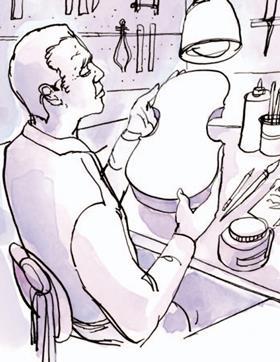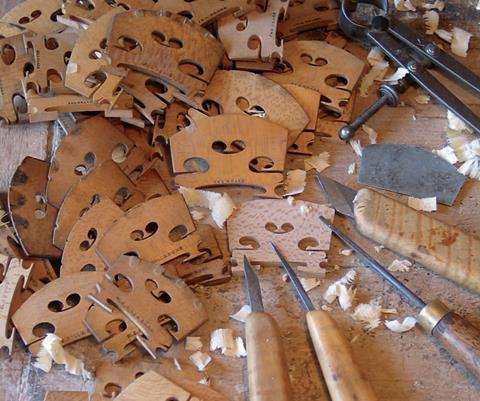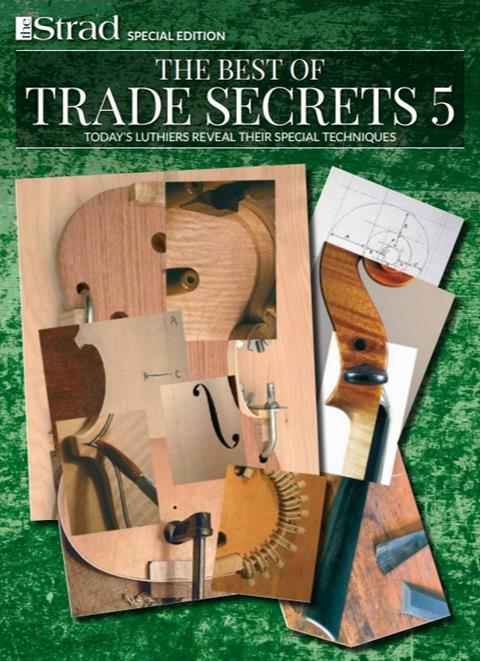John Dilworth pontificates on bridges in this article from September 2013

Discover more lutherie articles here
This article is from the September 2013 issue of The Strad
At a conservative rate of two a month, I’ve cut about 4,000 bridges over the course of my violin making career. So what have I learnt? Not a lot, it seems, as I try to write this. The one trick is a sharp knife. Well, three sharp knives, at least. The bridge is at the very heart of a violin’s sound. However much time you’ve spent adjusting the arching, the thickness, the tap tones, the whatevers, if the soundboard isn’t hooked up to the strings by a good bridge, it’s all a colossal waste of time. That’s one thing I’ve learnt.
So what makes a good bridge? It isn’t just that it carries your name: it has to work well. It must fit, first of all. It has to sit firmly and easily on the front arch without pressure or twisting. If it needs the pressure of the strings to push it down to a snug fit, it is not secure and will ultimately bend, deform and slip. Cut the feet with a sharp eye and a sharp knife, and the first part of the job is done. Next, get the string heights right. This is not so cut and dried. Different strings, different playing styles, different bows. The customer is always right. So what do you do with the hunk of wood in between?
One major aim should be to make it as light as possible, without it collapsing or distorting. But there are two schools of thought on how to achieve this. One dictates that you excavate as much as possible from under the bridge, making the lower arch high and round, and the ankles rather tall, and concentrate the mass in the higher breast of the bridge. From this comes a brilliant, cutting tone that can compensate for a dull, unresponsive instrument. The other way, which I like to think of as the London style, has the bottom sweep cut as low as possible, the ankles short and thin, and the centre of gravity of the bridge close to the table. It may sometimes lack the brilliance of the high-cut bridge, but it makes up for that with richness and depth.

Like most violin makers, I find it impossible to throw away an old bridge. Each one represents an individual craftsman doing their utmost to make this tiny slip of wood as elegant and efficient as possible. Most of the best bridges I have are simply branded ‘Hill’ or ‘Beare’. It is almost impossible to guess the individual who crafted it. But many of them are 50 years old or more. Despite the apparent fragility of this single gram weight of hardwood under the pressure of four highly tensioned strings, a good, well-judged bridge can and should last a lifetime. That’s what I’ve learnt.
Read: Trade Secrets: Fitting a bridge to a violin belly
Read: Looking after your instrument: the secret to bridge placement
Discover more lutherie articles here
This article is from the September 2013 issue of The Strad
An exclusive range of instrument making posters, books, calendars and information products published by and directly for sale from The Strad.
The Strad’s exclusive instrument posters, most with actual-size photos depicting every nuance of the instrument. Our posters are used by luthiers across the world as models for their own instruments, thanks to the detailed outlines and measurements on the back.
The number one source for a range of books covering making and stinged instruments with commentaries from today’s top instrument experts.
This year’s calendar celebrates the top instruments played by members of the Australian Chamber Orchestra, Melbourne Symphony, Australian String Quartet and some of the country’s greatest soloists.
Best of 2023: The Strad’s Twelve Days of Lutherie
- 1
- 2
- 3
- 4
- 5
- 6
 Currently reading
Currently readingSmall wonders: Building bridges
- 7
- 8
- 9
- 10
- 11
- 12
- 13






































































No comments yet